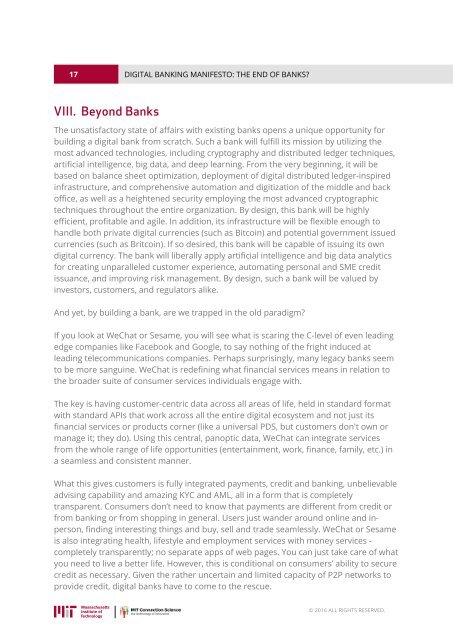Digital Banking Manifesto The End of Banks?
2cS8Ueo
2cS8Ueo
Create successful ePaper yourself
Turn your PDF publications into a flip-book with our unique Google optimized e-Paper software.
17<br />
DIGITAL BANKING MANIFESTO: THE END OF BANKS?<br />
VIII. Beyond <strong>Banks</strong><br />
<strong>The</strong> unsatisfactory state <strong>of</strong> affairs with existing banks opens a unique opportunity for<br />
building a digital bank from scratch. Such a bank will fulfill its mission by utilizing the<br />
most advanced technologies, including cryptography and distributed ledger techniques,<br />
artificial intelligence, big data, and deep learning. From the very beginning, it will be<br />
based on balance sheet optimization, deployment <strong>of</strong> digital distributed ledger-inspired<br />
infrastructure, and comprehensive automation and digitization <strong>of</strong> the middle and back<br />
<strong>of</strong>fice, as well as a heightened security employing the most advanced cryptographic<br />
techniques throughout the entire organization. By design, this bank will be highly<br />
efficient, pr<strong>of</strong>itable and agile. In addition, its infrastructure will be flexible enough to<br />
handle both private digital currencies (such as Bitcoin) and potential government issued<br />
currencies (such as Britcoin). If so desired, this bank will be capable <strong>of</strong> issuing its own<br />
digital currency. <strong>The</strong> bank will liberally apply artificial intelligence and big data analytics<br />
for creating unparalleled customer experience, automating personal and SME credit<br />
issuance, and improving risk management. By design, such a bank will be valued by<br />
investors, customers, and regulators alike.<br />
And yet, by building a bank, are we trapped in the old paradigm?<br />
If you look at WeChat or Sesame, you will see what is scaring the C-level <strong>of</strong> even leading<br />
edge companies like Facebook and Google, to say nothing <strong>of</strong> the fright induced at<br />
leading telecommunications companies. Perhaps surprisingly, many legacy banks seem<br />
to be more sanguine. WeChat is redefining what financial services means in relation to<br />
the broader suite <strong>of</strong> consumer services individuals engage with.<br />
<strong>The</strong> key is having customer-centric data across all areas <strong>of</strong> life, held in standard format<br />
with standard APIs that work across all the entire digital ecosystem and not just its<br />
financial services or products corner (like a universal PDS, but customers don't own or<br />
manage it; they do). Using this central, panoptic data, WeChat can integrate services<br />
from the whole range <strong>of</strong> life opportunities (entertainment, work, finance, family, etc.) in<br />
a seamless and consistent manner.<br />
What this gives customers is fully integrated payments, credit and banking, unbelievable<br />
advising capability and amazing KYC and AML, all in a form that is completely<br />
transparent. Consumers don’t need to know that payments are different from credit or<br />
from banking or from shopping in general. Users just wander around online and inperson,<br />
finding interesting things and buy, sell and trade seamlessly. WeChat or Sesame<br />
is also integrating health, lifestyle and employment services with money services -<br />
completely transparently; no separate apps <strong>of</strong> web pages. You can just take care <strong>of</strong> what<br />
you need to live a better life. However, this is conditional on consumers’ ability to secure<br />
credit as necessary. Given the rather uncertain and limited capacity <strong>of</strong> P2P networks to<br />
provide credit, digital banks have to come to the rescue.<br />
© 2016 ALL RIGHTS RESERVED.


